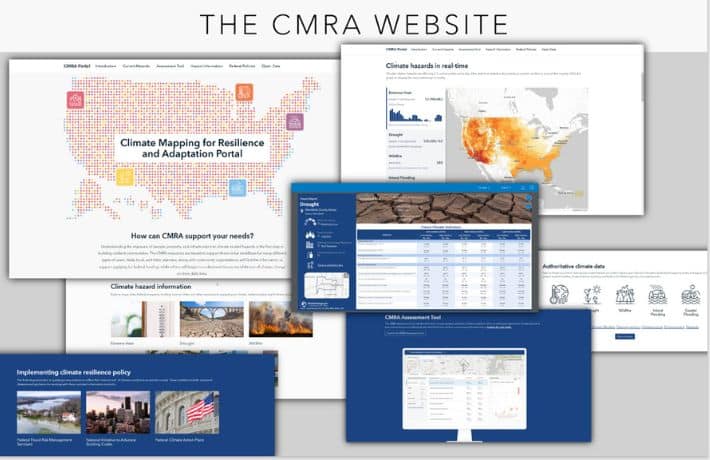New Portal to Help Communities Assess Exposure to Climate Hazards

A new website is now available to help state, local, tribal, and territorial governments understand the real-time climate-related hazards in their area, analyze projected long-term exposure to those hazards, and identify federal funds to support climate resilience projects for their communities.
The Climate Mapping for Resilience and Adaptation (CMRA) portal, an easily accessible and interactive geospatial website, is designed to equip those on the ground with the tools they need to plan and prepare, and to access federal resources to build greater resilience, according to Deputy National Climate Advisor Ali Zaidi. There is also a section of tools for community members to help them understand the climate risks in their area and actions they can take to mitigate those risks.
Announced by the White House this week, in partnership with the National Oceanic and Atmospheric Administration (NOAA) and the Department of the Interior (DOI), the CMRA portal, features:
- Real-time monitoring dashboard: To help track the climate-related hazards that are affecting communities each day, a new dashboard brings together maps showing areas currently under extreme heat advisories, drought conditions, and inland and coastal flooding warnings, as well as the locations of active wildfires and areas of poor air quality they produce.
- Assessments of local climate exposure: In addition to real-time data about extreme weather events, the portal also helps communities understand their historic and future exposure to various climate impacts. The portal’s Assessment Tool provides hazard reports on heat, drought, and flooding down to the census tract level, including projections of future impacts in both low and high-emissions scenarios, based on climate models used in the U.S. National Climate Assessment. This interactive application will help local resilience planners and other users understand how future temperature, precipitation, and flooding conditions may impact their community in the near-term and by mid- and late-century.
- Funding opportunities and other federal resources: The portal also centralizes federal data, programs, and funding opportunities that are available to support resilience efforts—including resources for various climate hazards. The CMRA Assessment Tool will also help state, local, Tribal, and territorial governments develop data-driven proposals to access federal funding.
The portal’s Assessment Tool also integrates data and information with such recent federal initiatives as the Climate and Economic Justice Screening Tool, which identifies disadvantaged communities; the Building Code Adoption Tracking Portal; and the 2022 Sea Level Rise Technical Report.
In addition, users can explore maps, data, federal programs, funding opportunities, and other resources to support climate resilience planning across five key climate hazards: extreme heat, drought, wildfire, flooding, and coastal inundation.
For example, the section on flooding features
- A series of interactive maps on precipitation predictions over the next 72 hours and in 2050, as well as identified flood hazard areas
- Links to a variety of federal funding opportunities from FEMA, USDA, and EPA
- Select resources, including the USGS National Water Dashboard and Flood Event Viewer, NOAA’s River Forecast Center, and more.

The collaborative interagency group developing CMRA includes the White House Domestic Climate Policy Office, Office of Science and Technology Policy, and Council on Environmental Quality; Office of Management and Budget; and members of the White House Climate-Smart Infrastructure Interagency Working Group.
CMRA was developed by Esri, a geographic information system software company, through a contract with NOAA. Development of CMRA was co-funded by NOAA and the Department of Interior.
Explore the CMRA web portal at resilience.climate.gov.


